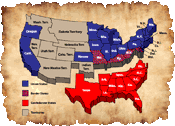Confederate Infantry Facts
The Union government and the Confederate government both had war departments, which oversaw the organization, supply, and movements of their respective armies. Civil War-era armies were organized according to military manuals including those adopted by the Union War Department prior to 1861.
Because the war had to be fought over a large area of the South, the Union and the Confederacy both had several armies, each fighting in different "theaters" or sections of the country. Army structured organization included: General Headquarters, Infantry, Artillery, Cavalry, Signalmen, Engineers, Quartermaster Department and Commissary Departments
- Corps: Includes 3 Infantry divisions and an Artillery brigade (Union) or an Artillery Battalion (Confederate). Typically, a Confederate corps was much larger than a Union corps.
- Division: was commanded by a Major or a Brigadier General and composed of 2 to 4 infantry brigades
- Brigade: Commanded by a Brigadier General, was composed of 4 to 6 regiments, and was the primary organization used by commanders in battle. It was common practice for a brigade commander to send forward most of his regiments and hold one in reserve.
- The Confederate War Department made attempts to have brigades composed of regiments from one singular state or state affiliation, such as Gen. Joseph Kershaw's brigade which was all South Carolina regiments. The Union Army did not always make such conscious choices, though there were some brigades which acquired interesting nick names due to their ethnic origin or locality from which they hailed.
- Regiment: Divided into 10 companies of 100 men each at full strength. Regiments fought in a "battle line" or in some cases a "skirmish line", which was a general open rank tactic used to feel out the strength of an enemy force. For the infantryman, his regiment was the most important unit. Led by a Colonel, Lt. Colonel and Major, a full strength regiment numbered over 1,000 officers and men.
- Company: Divided in half as 2 platoons. One company was led by a Captain with 2 Lieutenants, who each commanded a platoon.
- Platoon: Divided into squads, led by a Sergeant or Corporal.
At the outbreak of the Civil War, there was a standing force of "regular" units in the United States Army. State militias were called into service, but there was a need to Federalize these units so that they could muster pay from the United States government and serve outside of state borders. Each state was given a quota of "volunteer regiments" to be raised for service lasting from three months to three years.
The South faced a similar dilemma. Southern states raised and supplied the Confederate armies with volunteer regiments. By 1863, many of the regiments in both armies had been in service since 1861 and were still composed of mostly volunteer soldiers, though the first "conscripts" or men required by state law to serve in the military defense of a state, had begun to appear in Southern units. A regiment's flag, or "regimental colors", were painted with the regiment's number and state affiliation, usually followed by "VOLUNTEER INFANTRY". The term volunteer was a symbol of pride for soldiers on both sides.
Rifle and Light Infantry Tactics For The Exercise and Maneuvers of Troops When Acting As Light Infantry Or Riflemen, written by William J. Hardee. The most widely used manual for small units (regiments). The manual specified the proper placement of officers, the rank and file, the manual of arms, basic marching orders, and other requirements. His manual was re-written for Confederate use in 1861 when Hardee resigned his commission from the United States Army and joined the Confederacy. Other manuals of organization and drill were used, but "Hardee's Tactics" continued to be the most popular and widely used manual throughout the war.
The basic weapon of an infantry soldier was the single-shot, muzzle-loading percussion musket. Foremost among these was the Springfield, manufactured at the U.S. Armory in Springfield, Massachusetts, and at other locations. All were generically referred to as "Springfields" by the troops. By the end of the war, total production approached 1.5 million weapons. The Springfield had a 39 inch long rifled barrel, and could fire a .58 caliber bullet effectively at targets 500 yards distant.
After the Confederate capture of the Federal armory at Harper's Ferry, Virginia (later West Virginia), more than 64,000 Confederate copies were produced.
A variety of other European rifles were used by the infantry of both sides. Among the most prolific of this "second class" of rifled arms was the Austrian Lorenz. Over 225,000 were purchased by the Federal government alone. Many of these .54 caliber rifles were rebored to accept the standard .58 caliber ammunition.
While rifles were preferred for their long range and accuracy, many older smooth-bore muskets of foreign and domestic manufacture saw service as well. Chief among these was the 1842 Springfield. This weapon had a 42 inch long, .69 caliber barrel. It fired one solid .69 caliber round lead ball, along with 3 small buckshot. Produced until 1855 at Springfield, Massachusetts and at Harper's Ferry, Virginia (now West Virginia), 172,000 were made. Some of these (about 10,000) were later rifled in the pre-war period.
The bulk of these, however, were issued as smoothbores to Civil War troops. Without the extra range of a rifle, soldiers so armed found themselves handicapped against an enemy armed with rifles.

